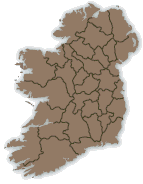An cailín deas rua - Aindréas Ó Gealbháin
Recording: [Download audio file]
[Download AIFF audio file (of processed ‘user’ version)]
[Download AIFF audio file (of archive version)]
Transcript
Á, Tiobrad Ára(nn) d'fhágas ar maidin Dé Luain,
Níor stadas don stáir sin go dtána go Caiseal ar cuan,
Cé gheobhainn ar ceann cláir ach mo ghrá agus í dh'imirt ar an scuaib
Is nuair a bhuaigh sí an cíoná bhí an lá lem chailín deas rua.
Nuair a bhuaigh sí chúig phúint bhí dúbailt deal ar an
mbord,
Cupa dhon lionn agus fliúit á sheinm chun ceoil,
Bhí an buidéal fíon fionn aigem rún[1] agus mise á ól
Is nuair a chailleas an chúig adúirt sí tá an (chluiche anseo
romhat).
(Sí) do chois deas i mbróig, a stór, nach deas é do shiúl,
Ní deise é an lá ná claonadh agus leigean do shúl
Níl aon bhean sa deoise, arú, a stór liom, is deise ná thú
Agus sín chugham do phóg, a stór, go mbeimid ar siúl.
Translation
I left Tipperary on Monday morning,
I didn't stop from my journey until I came to Cashel (...),
Who would I see at the head of the table but my love playing the sweep (?),
And when she won the five of trumps the day belonged to my nice red-haired
girl.
When she won five pounds there was a double deal (?) on the table,
A cup of beer and a flute playing music,
My love had the bottle of white wine and I was drinking it
And when I lost the five she said the game is here before you (?).
It's(?) your fine foot in a shoe, my love, how nice is your walk,
The day isn't finer than the form and look of your eye,
There is no woman in the diocese, ah, my dear, nicer than you
And give me your kiss, my love, until we are off.
Commentary
Aindréas Ó Gealbháin starts here with the second verse of this love song. Under the pseudonym 'Finghin na Leamhna', Fionán Mac Coluim published a version of the song in Cnuasach sean-rócán (Dublin, 1904), 29-30. This version comprises seven verses to be sung to the melody usually associated with the song 'Bean an Fhir Rua'. The opening verse is given as follows: In aisling dom féin aréir’s mé’m leabaidh trí’m shuan / Go rabhas-sa ’dul ’om pósadh lem’ stór chroidhe go hintinneach suairc, / Bhí rinnce is ceól is ceól sídhe d’á spreagadh im’ chluais / Agus céad giní óir ar an mbórd lem’ chailín deas ruadh. Father Pádraig Breathnach also published a seven-verse version of the song as 'Cailín Deas Ruadh' in Fuínn na smól: cuid a sé (Dublin, 1913), 5, as well as in Ceol ár sinsear (Dublin, 1923), 165. Donnchadh Ua Braoin includes it in An cuaichín ceoil: cuid a 3-4 (Dublin, Belfast, Cork, 1933), 88. The Irish Folklore Commission collected many versions of the song. For example: National Folklore Collection (UCD) Manuscripts 47 (pp. 309-11), 89 (pp. 138-9) and 132 (p. 80). The song 'An Cailín Ruadh' which is published in Lorcán Ó Muireadhaigh, Amhráin Chúige Uladh (Dundalk, 1927), 17, is unrelated to 'An Cailín Deas Rua'.
The melody here is usually referred to as 'An Capaillín Bán'. It appeared as 'The Roving Pedlar' in Bartlett Cooke (ed.), Forty eight Irish country dances (c. 1805) which is reprinted in Aloys Fleischmann, Sources of Irish traditional music c.1600-1855 (New York, 1998), no. 4213. For other songs set to this melody cf. 'Amhrán Molta an Daingin' in Seán Ó Dubhda, Duanaire Duibhneach (Dublin, 1933), 42-44, 'Hide and Go Seek' in Treoir 35 (2003), and Diarmaid Ó Muirithe, An t-amhrán macarónach (Dublin, 1980), 70. Liam Devally can be heard singing the song 'An Capaillín Bán' to the same melody on an LP entitled Cabaret Gael-Linn (c. 1960) and the esteemed sean-nós singer Mikie Ó Súilleabháin, of Cúil Aodha, county Cork, sings 'Hide and Go-Seek' on Traditional songs and singers (Comhaltas Ceoltóirí Éireann, 1977), also to the same melody.
A different melody entitled 'An Cailín Deas Rua' was published in Edward Bunting, Ancient music of Ireland (Dublin, 1840), 66; see Bunting’s Ancient music of Ireland: edited from the original manuscripts by Donal O’Sullivan with Mícheál Ó Súilleabháin (Cork, 1983), 133-4. This other melody has also been used for various songs. For example, 'Beauty Deas an Oileáin', published in Duanaire Duibhneach (see above). See also P.W. Joyce, Old Irish folk music and song (Dublin, 1909), 53-4.
Title in English: The nice red-haired girl
Digital version published by: Doegen Records Web Project, Royal Irish Academy
Description of the Recording:
Speaker:
Aindréas
Ó Gealbháin from Co.
Kerry
Person who made the recording:
Wilhelm Doegen
Organizer and administrator of the recording scheme: The Royal Irish Academy
In collaboration with: Lautabteilung, Preußische Staatsbibliothek (now Lautarchiv,
Humboldt-Universität zu Berlin)
Recorded on 10-09-1928 at 15:35:00 in Convent
of Mercy, Killarney (office). Recorded on 10-09-1928 at 15:35:00 in Convent
of Mercy, Killarney (office).
Archive recording (ID LA_1063d2, from a shellac disk stored at the
Royal Irish Academy) is 01:28 minutes
long. Archive recording (ID LA_1063d2, from a shellac disk stored at the
Royal Irish Academy) is 01:28 minutes
long.
User recording (ID LA_1063d2, from a shellac disk stored at the Royal
Irish Academy) is 01:25 minutes long. User recording (ID LA_1063d2, from a shellac disk stored at the Royal
Irish Academy) is 01:25 minutes long.





